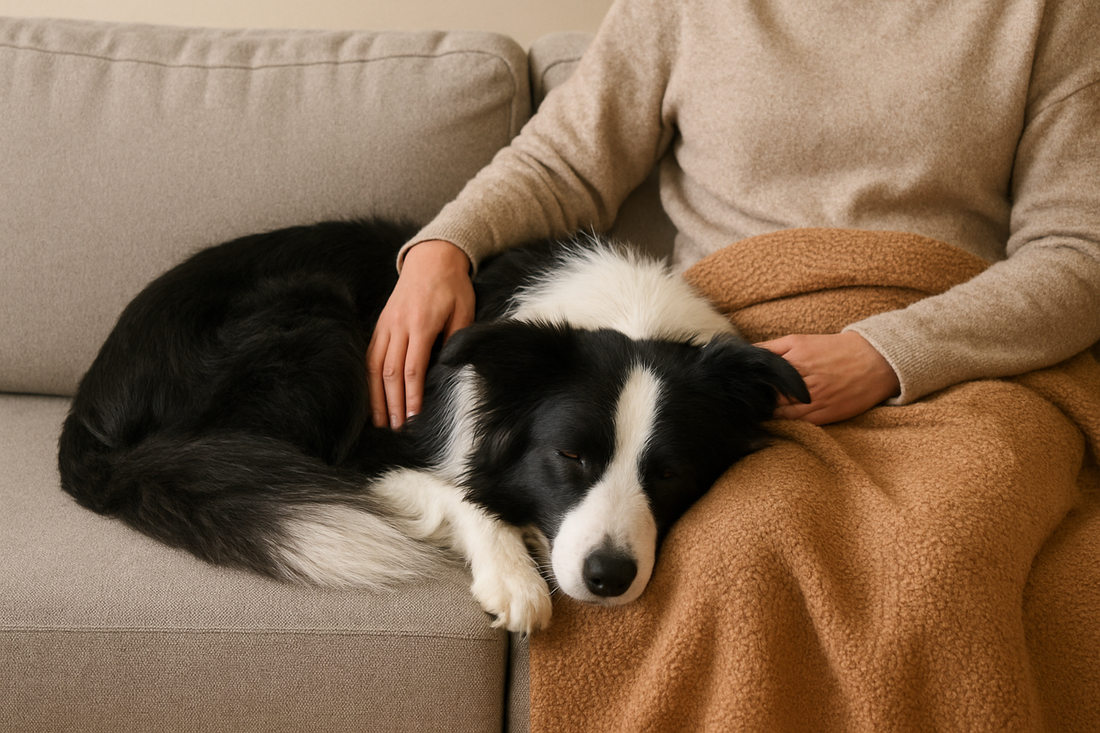
DOG ANXIETY: 7 Natural Ways to Calm Your Anxious Dog
Does your dog pace, whine, or panic every time you leave the house? Maybe they tremble during thunderstorms, bark uncontrollably at fireworks, or hide when visitors come over. If so, you’re not alone — millions of pet parents deal with dog anxiety every day.
The good news? With the right natural calming methods, you can help your dog feel safe, confident, and relaxed. This guide explains the signs of anxiety in dogs, the different types of triggers, and natural remedies that truly work to bring peace to your furry friend.
🐾 Signs Your Dog May Have Anxiety

Dogs can’t tell us when they’re anxious, but their body language and behavior reveal a lot. Recognizing the signs early can help you take action before the anxiety becomes severe.
Here are some common signs of dog anxiety to watch for:
- Constant pacing or restlessness
- Excessive barking, whining, or howling
- Destructive chewing, digging, or scratching at doors
- Shaking, drooling, or panting even when it’s not hot
- Accidents in the house (even if potty-trained)
- Hiding, avoiding eye contact, or clinging to you excessively
- Loss of appetite or refusal to play
- Trying to escape from the house or crate
If your dog shows several of these behaviors regularly, it’s a strong indicator of anxiety or stress — not disobedience. Understanding what your dog is trying to communicate is the first step toward helping them feel safe again.
⚡Types of Anxiety in Dogs
Not all anxiety looks the same. Some dogs fear being alone, while others react to loud noises or unfamiliar places. Identifying the type of anxiety your dog experiences helps you choose the most effective solution.
1. Separation Anxiety
This is one of the most common forms. Dogs with separation anxiety feel intense distress when left alone. You may notice barking, whining, destructive chewing, or attempts to escape when you leave.
Tip: Start practicing short departures — leave for just a few minutes, then gradually increase the time. Pair your absence with positive experiences like treats or toys.
2. Noise Anxiety
Thunderstorms, fireworks, and even vacuum cleaners can trigger fear in sensitive dogs. Common symptoms include shaking, hiding, pacing, or barking during these events.
Tip: Desensitization (gradual exposure to recorded sounds at low volume) can help your dog become less reactive over time.
3. Travel Anxiety
Car rides and new environments can make some dogs nervous. They might drool, pant, or cry during travel.
Tip: Start with short drives around the block, and always bring familiar comforts like their favorite blanket or toy.
4. General Anxiety
Some dogs are naturally more nervous, often due to past trauma, genetics, or lack of socialization. These dogs may seem “on edge” most of the time.
Tip: A stable daily routine, gentle handling, and consistent positive reinforcement help these dogs feel secure.
🌿7 Natural Ways to Calm an Anxious Dog
These vet-recommended, natural calming methods can help reduce your dog’s stress safely — without harsh medications or side effects.
1. Exercise & Playtime
Regular physical activity releases endorphins, natural chemicals that improve mood and reduce anxiety. Exercise also burns excess energy that might otherwise turn into nervous behavior.
Activities like long walks, fetch, agility games, or swimming can all help. Aim for 30–60 minutes daily, depending on your dog’s breed, age, and health.
A tired dog is a calm dog. Beyond physical benefits, exercise strengthens your bond and builds trust — which is essential for anxious pups.
2. Calming Music & White Noise
Sound therapy can be surprisingly powerful. Soft classical music, lullabies, or white noise can soothe your dog’s nerves and mask frightening sounds like thunder or fireworks.
You can find playlists made specifically for dogs on Spotify or YouTube.
For dogs with separation anxiety, leaving calming music on while you’re away can help them feel less alone.
Bonus idea: Try heartbeat simulators — plush toys that mimic a mother dog’s heartbeat — for puppies or rescue dogs that crave comfort.
3. Weighted Blankets & Thundershirts
Gentle, constant pressure on the body creates a sense of safety, similar to a calming hug.
Thundershirts, anxiety wraps, or weighted blankets are especially helpful during stressful situations like storms, car rides, or vet visits.
Make sure they fit snugly but not too tightly, and let your dog wear them for short periods at first to get used to the sensation.
4. Aromatherapy & Essential Oils (Used Safely)
Certain scents — such as lavender, chamomile, or frankincense — can promote relaxation for dogs.
Use a pet-safe diffuser in a well-ventilated room and always ensure your dog can leave if they don’t like the smell.
⚠️ Important safety tips:
- Never apply essential oils directly to your dog’s skin or fur.
- Avoid oils like tea tree, peppermint, and eucalyptus — these can be toxic.
- Always consult your vet before starting aromatherapy, especially for dogs with respiratory issues or sensitivities.
Even simple scents like freshly washed bedding or a favorite blanket can have a calming effect, reminding your dog of safety and comfort.
5. Natural Calming Treats & Supplements
Many dogs benefit from natural supplements that reduce anxiety gently without causing drowsiness. Look for dog-safe ingredients such as:
- L-theanine – supports relaxation and mental focus
- Chamomile – a mild herbal relaxant
- Valerian root – reduces nervous tension
- Passionflower – supports a calm mood and sleep
- *CBD oil – may ease stress and promote calmness (vet approval recommended)
Always choose high-quality products from trusted pet brands, and follow dosing instructions carefully. Results vary — some dogs respond in minutes, while others need a few weeks for consistent results.
6. Interactive Toys & Puzzle Feeders
Mental stimulation is just as important as physical exercise. Toys that make your dog think, sniff, and solve problems help redirect anxious energy and build confidence.
Try:
- KONG toys stuffed with treats or peanut butter
- Snuffle mats for scent-based play
- Puzzle feeders that make mealtime more engaging
When your dog’s brain is busy, their anxiety decreases. This approach is especially effective for dogs with separation anxiety or boredom-related stress.
7. Training & Desensitization
Behavioral training teaches dogs how to respond calmly to stressful triggers. The process, called desensitization and counter-conditioning, helps replace fear with positive associations.
For example:
- Start by leaving your dog alone for just one minute.
- Return calmly and reward them for staying relaxed.
- Gradually increase the time and distance over several weeks.
During noise training, you can play thunder or fireworks sounds at a low volume while offering treats. Over time, your dog learns these sounds aren’t dangerous.
Consistency is key. Stay calm, use gentle praise, and never punish fearful behavior. Training should always build trust, not fear.
🏡 Creating a Calming Environment
Small adjustments at home can dramatically improve your dog’s comfort and sense of safety.
Here’s how to make your home more anxiety-friendly:
- Designate a safe space: A crate with soft bedding, a cozy corner, or a quiet room away from noise.
- Keep a consistent schedule: Dogs thrive on predictability — feed, walk, and rest at similar times daily.
- Use calming scents and low lighting: Soft light and a familiar smell help dogs relax during stressful events.
- Limit overstimulation: Turn off loud TVs, close windows during fireworks, and use blackout curtains if needed.
- Avoid punishment: Scolding anxious behaviors can increase fear. Instead, use a calm tone and redirect them gently.
Tip: During holidays like the Fourth of July or New Year’s Eve, prepare in advance. Play calming music, keep your dog indoors, and stay nearby to reassure them.
🩺 When to See a Vet or Trainer

While natural remedies help most mild to moderate anxiety cases, some dogs need professional support.
Consult your veterinarian or a certified behaviorist if your dog shows signs such as:
- Self-injury (biting or licking until skin breaks)
- Persistent pacing, barking, or howling for hours
- Refusal to eat or drink
- Aggression triggered by fear
- Panic attacks or escape attempts
A vet can rule out medical causes (like thyroid issues or pain) and may suggest safe medications or supplements to complement natural methods.
A certified dog trainer or animal behaviorist can design a customized plan for your dog’s specific triggers.
Combining professional guidance with natural approaches gives your dog the best chance for long-term emotional stability.
🔬 Expert Insights & Safety Notes
According to the American Kennel Club (AKC), maintaining a consistent daily routine, providing regular exercise, and using positive reinforcement are among the most effective long-term strategies to manage anxiety.
Veterinary behaviorists emphasize that while natural calming methods can be very effective, each dog is unique — what relaxes one might not work for another. The key is patience, observation, and adjustment.
⚠️ CBD Caution: While CBD oil shows promise for reducing stress in dogs, its legality, dosage, and quality vary widely. Always consult your veterinarian before use, especially for small dogs or those on medication.
🎯 Final Thoughts
An anxious dog isn’t a “bad dog” — they’re simply overwhelmed or afraid. With your love, patience, and the right combination of natural calming techniques, your dog can learn to feel safe and confident again.
Remember:
- Stay consistent.
- Celebrate small wins.
- Be patient — progress takes time, not perfection.
By combining exercise, mental enrichment, calming aids, and training, you’ll create an environment where your dog can truly relax.
Your furry friend depends on you to guide them toward calm — and with compassion and commitment, you can help them rediscover joy, trust, and peace.
👉 Want more practical pet solutions? Check out our guide: Why Is My Dog Chewing Everything? 7 Proven Solutions That Work
Tags: calm anxious dog, dog anxiety solutions, how to relax a dog, separation anxiety in dogs, Dog anxiety, Natural remedies for dog anxiety, Calming dogs naturally, Dog anxiety symptoms, Dog separation anxiety, How to calm an anxious dog, Dog anxiety treatment, CBD for dogs, Noise anxiety in dogs, Natural dog calming treats, calming dogs naturally, Natural Dog Care, Pet Wellness, Calming Tips, Dog Training, Dog Behavior



